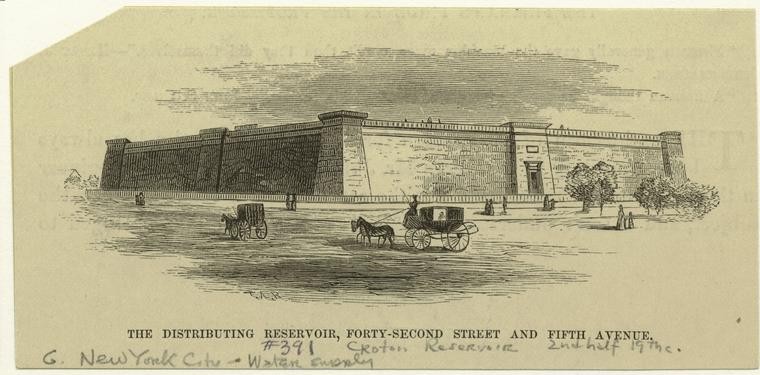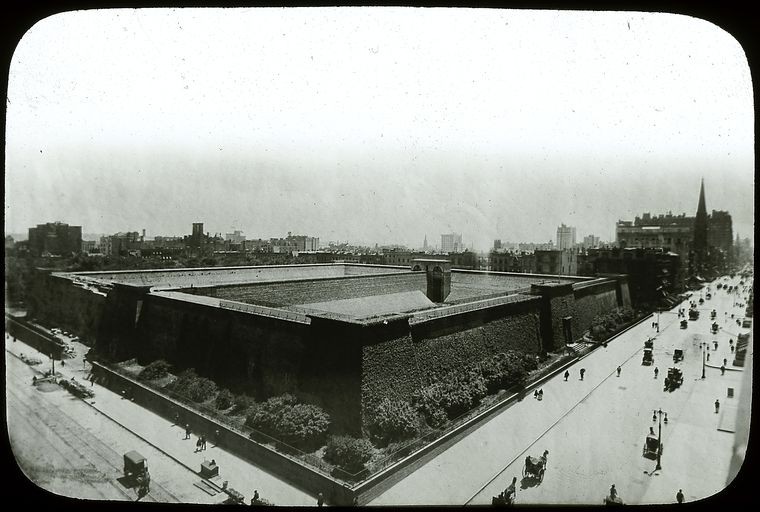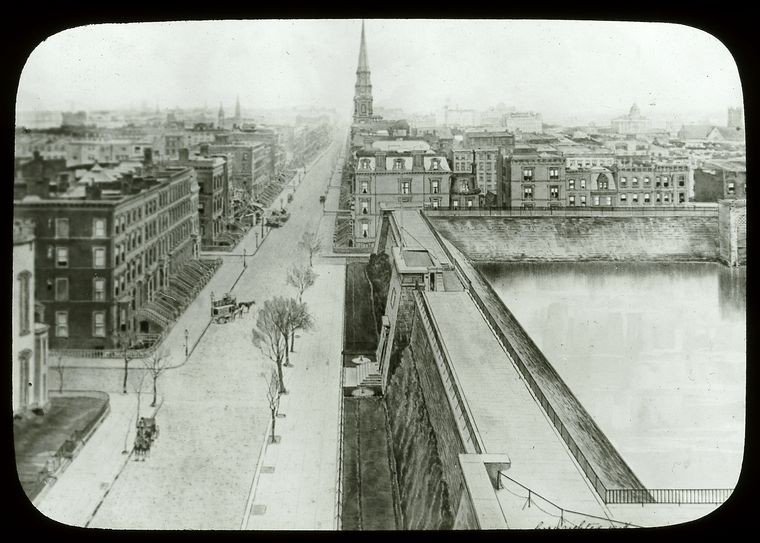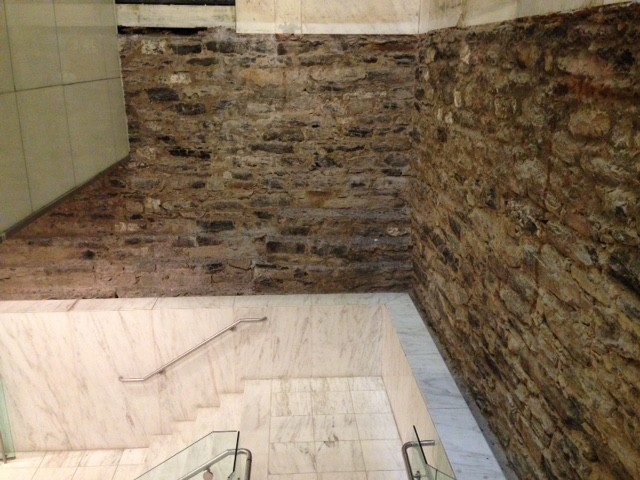Former Site of the Croton Distributing Reservoir (1842~1890s)
Introduction
Text-to-speech Audio
Images
A sketch of the reservoir from 1882

A photograph of the reservoir while in the process of demolition in 1900

A drawing from a photograph of Fifth Avenue looking south in 1879 provides a partial aerial glimpse of the reservoir

The granite remains of the reservoir's foundation are still visible today inside the library

Backstory and Context
Text-to-speech Audio
From the colonial era to the early 1840s, residents of New York City obtained their drinking water from wells fed by underground streams, cisterns and wooden barrels that collected rainwater, and natural springs and ponds. In the late eighteenth and early nineteenth centuries, the city experienced rapid population growth. This, coupled with continued poor sanitation practices, led to a continuous decline in drinking water quality. In 1832, a cholera epidemic struck the city, leaving more than 3,000 people dead in its wake. The disaster finally convinced New Yorkers to support the construction of the city’s first public water network.
The result was a nineteenth-century engineering marvel and public health milestone for the city, the Croton Aqueduct. Built on the backs of thousands of Irish immigrant laborers between 1837 and 1842, the system provided residents of New York City with a steady supply of clean, healthy drinking water. In northern Westchester County, a dam collected water from the Croton River and its tributaries. From there, gravity carried the water through forty-one miles of masonry-encased cast iron pipes to the Yorkville Receiving Reservoir, an above-ground reservoir located on what is now Central Park’s Great Lawn. The water then traveled southward to the Croton Distributing Reservoir, where cast iron pipes branching off from the reservoir disseminated it to businesses, public buildings, and residences on the southern end of Manhattan. Capable of carrying approximately 100 million gallons of water per day, the aqueduct system officially opened in 1842 to great public excitement and fanfare. The total cost of the project was a whopping $11.5 million.
The Croton Distributing Reservoir was a formidable structure. Essentially a man-made, four-acre above-ground lake, it boasted fifty-foot-tall and twenty-five-foot thick granite walls. The reservoir contained two gigantic basins, which held a combined total of twenty million gallons of water. Along the tops of the walls, public promenades offered visitors a unique perspective of the surrounding area, which was still being developed at the time of the reservoir’s completion. Built in the Egyptian Revival style, the reservoir sought to link New York City to Egypt and other ancient civilizations that developed their own water systems.
Observers at the time of its opening boldly predicted that the Croton Aqueduct would endure for ages. They were wrong. New York City’s population continued to increase dramatically. Consequently, the demand for clean, healthy drinking water did as well. Despite delivering approximately 100 million gallons of water per day, the Croton Aqueduct simply could not keep pace with demand. In the late nineteenth century, in an effort to capture as much water from the Croton Watershed as possible, the City of New York built what became known as the New Croton Aqueduct. Demand for water in the city, however, soon outpaced what the two aqueducts could supply and the City of New York began looking for water sources farther away. The original Croton Aqueduct, however, continued to supply the city with water until the mid-twentieth century.
The Croton Distributing Reservoir met its end around the beginning of the twentieth century. Throughout the latter half of the nineteenth century, the area that surrounded the reservoir experienced rapid development. Brownstones and paved streets sprang up where once there were only scattered homesteads and dirt roads. Residents of the area believed that the reservoir disrupted the urban aesthetics of the neighborhood and moved several times to have it demolished. In the 1890s, the City of New York approved plans for the construction of the New York Public Library on the site. The reservoir was then drained and dismantled. Construction on the library began in 1902 and nine years later it opened to the public. The granite remains of the reservoir’s foundation are still visible today inside the library.
Sources
"History." Bryant Park. Bryant Park Corporation. Web. 12 January 2021 <https://bryantpark.org/blog/history>.
Miller, Tom. "The Lost Egyptian Revival Croton Reservoir -- 5th Avenue and 42nd Street." Daytonian in Manhattan: The Stories Behind the Buildings, Statues and Other Points of Interest that Make Manhattan Fascinating. <http://daytoninmanhattan.blogspot.com/2011/11/lost-egyptian-revival-croton-reservoir.html>.
"Old Croton Aqueduct State Historic Park." Parks, Recreation, and Historic Preservation. New York State. Web. 12 January 2021 <https://parks.ny.gov/parks/oldcrotonaqueduct/details.aspx>.
"Old Croton Aqueduct Trail." New York City Department of Parks and Recreation. The City of New York. Web. 12 January 2020 <https://www.nycgovparks.org/park-features/virtual-tours/old-croton-aqueduct-trail>.
Soll, David. Empire of Water: An Environmental and Political History of the New York City Water Supply. Ithaca: Cornell University Press, 2013.
https://digitalcollections.nypl.org/items/510d47e1-06fd-a3d9-e040-e00a18064a99
https://digitalcollections.nypl.org/items/510d47da-ea34-a3d9-e040-e00a18064a99
https://digitalcollections.nypl.org/items/510d47da-ea38-a3d9-e040-e00a18064a99
https://ephemeralnewyork.wordpress.com/2014/12/08/the-granite-remains-of-a-19th-century-reservoir/
